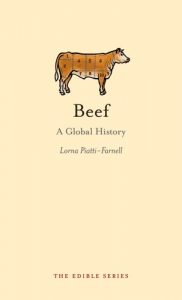Beef is everywhere, throughout history and around the globe. Starting from the premise that beef farming, cooking and eating can be found in virtually all countries in the world, Beef explores the social, cultural and economic factors that shaped the production and consumption of beef throughout history.
Describing how the ‘class status’ of beef has changed through time, Beef discusses how this meat has been revalued: once the main constituent of hearty, vernacular stews, beef is now showcased in the most elaborate dishes of Michelin-starred chefs today. The book also considers the place occupied by beef in art, literature and historical cookbooks, and – paying attention to ethical issues in the production of the meat – offers a consideration of the future of beef.
Aimed at the general reader with an interest in history, food and culture, Beef also has much to say to scholars and students of food, and agrarian, history. Featuring many fine images of beef in nature, art and cuisine around the world, Beef will appeal as much to lovers of flame-grilled hamburgers as the molecular gastronomy of Heston Blumenthal.
Describing how the ‘class status’ of beef has changed through time, Beef discusses how this meat has been revalued: once the main constituent of hearty, vernacular stews, beef is now showcased in the most elaborate dishes of Michelin-starred chefs today. The book also considers the place occupied by beef in art, literature and historical cookbooks, and – paying attention to ethical issues in the production of the meat – offers a consideration of the future of beef.
Aimed at the general reader with an interest in history, food and culture, Beef also has much to say to scholars and students of food, and agrarian, history. Featuring many fine images of beef in nature, art and cuisine around the world, Beef will appeal as much to lovers of flame-grilled hamburgers as the molecular gastronomy of Heston Blumenthal.






